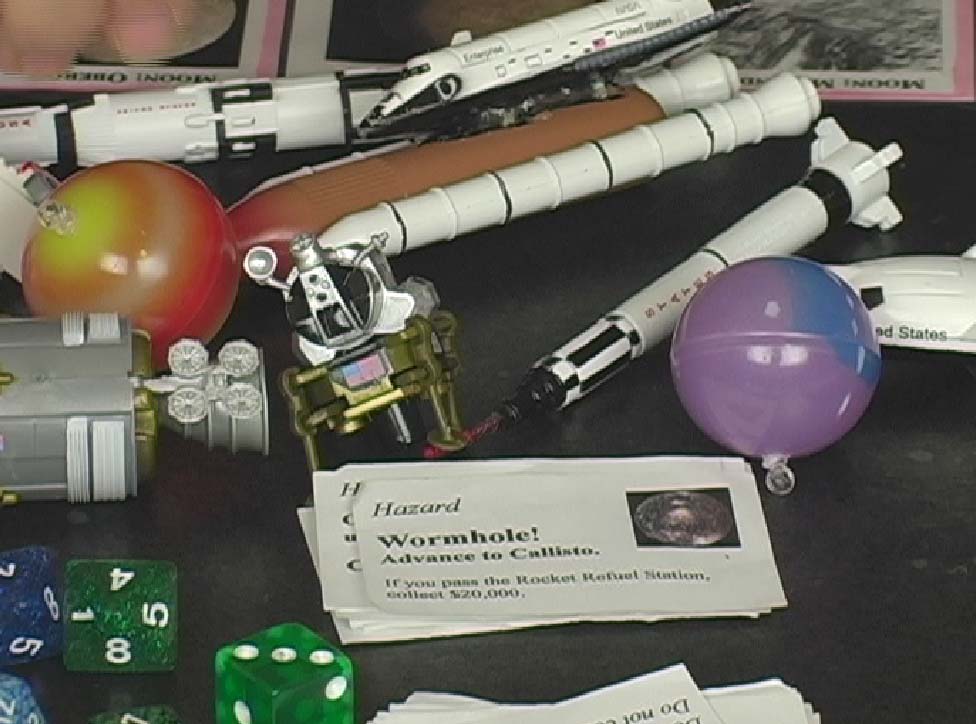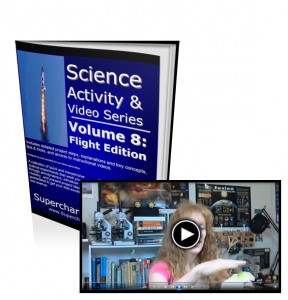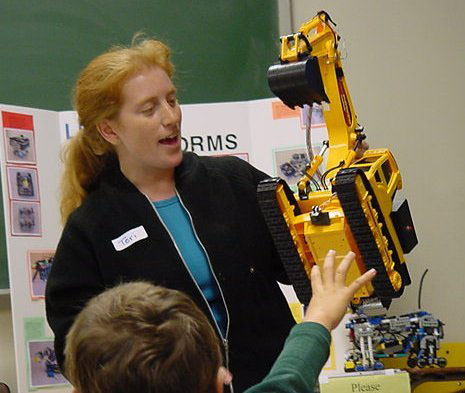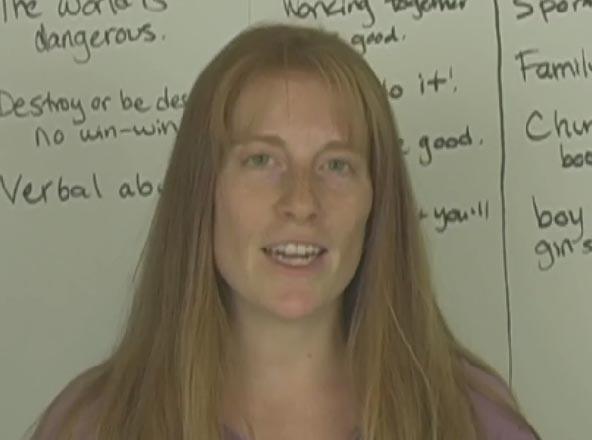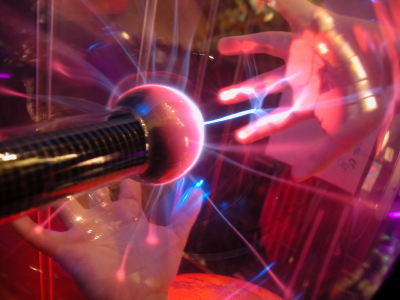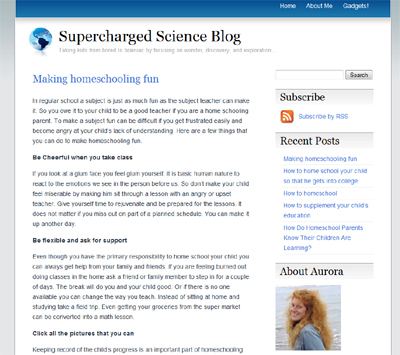 It has got to be said that when you homeschool your children you are running two very different portfolios. One is that of teacher in the homeschool classroom and the other is that of home maker and care taker. Needless to say one set of responsibilities often imposes on the other and can make it tough going for the homeschooling mom. Here are some ways to balance the scales.
It has got to be said that when you homeschool your children you are running two very different portfolios. One is that of teacher in the homeschool classroom and the other is that of home maker and care taker. Needless to say one set of responsibilities often imposes on the other and can make it tough going for the homeschooling mom. Here are some ways to balance the scales.
Please login or register to read the rest of this content.
 Studies in adults have proved that overnight sleep can help them assimilate new information better. Sleep helps consolidate new memories and makes them easier to access on a later date. However there was no evidence to support the fact that a daytime nap will help a student learn better till Psychologist Rebecca Spencer of the University of Massachusetts, Amherst, conducted her study. Rebecca used her own children, daughters then aged 3 and 5, to help answer the question, “How well did a child learn when she napped, and what happened when she didn’t?”
Studies in adults have proved that overnight sleep can help them assimilate new information better. Sleep helps consolidate new memories and makes them easier to access on a later date. However there was no evidence to support the fact that a daytime nap will help a student learn better till Psychologist Rebecca Spencer of the University of Massachusetts, Amherst, conducted her study. Rebecca used her own children, daughters then aged 3 and 5, to help answer the question, “How well did a child learn when she napped, and what happened when she didn’t?”
Please login or register to read the rest of this content.
 The focus of educators in recent years has been to encourage science and technology based education in order to meet the shortfall in skilled labor at the industrial level. This had resulted in the STEM or Science, Technology, Engineering and Mathematics based subjects getting a boost at the schools. However now there is a group of educators who feel that being innovative in science requires you to have adequate exposure to arts. They are now hoping to add arts to the mix and make it STEAM.
The focus of educators in recent years has been to encourage science and technology based education in order to meet the shortfall in skilled labor at the industrial level. This had resulted in the STEM or Science, Technology, Engineering and Mathematics based subjects getting a boost at the schools. However now there is a group of educators who feel that being innovative in science requires you to have adequate exposure to arts. They are now hoping to add arts to the mix and make it STEAM.
Please login or register to read the rest of this content.

The workspace is an important area of our lives. If it is organized and uncluttered we are likely to be much more productive as per scientific studies conducted. It is easy to extend this to the work station for a child in homeschool. The student’s work station is likely to influence how well, or badly the student does his or her work. What all do you need to have in an ideal work station for your homeschool student?
Please login or register to read the rest of this content.

While concept of engineering may bring to mind far older and more studious children, it is possible to have fun with engineering activities even in elementary school. Here is how you can use this activity in your elementary homeschool classroom. Start with the story of the “Three Little Piggies”. This can consist of either a story telling session or an actual reading of a picture book. Once you have the huff and puff down pat, ask them to actually build the homes of the piggies in miniature on the dining table.
Please login or register to read the rest of this content.
 One of the simplest scientific unit studies can be based on the principle of gravity. It can involve students from kindergarten to the highest grade. Here is a set of activities and projects that you can undertake with your homeschool students using gravity.
One of the simplest scientific unit studies can be based on the principle of gravity. It can involve students from kindergarten to the highest grade. Here is a set of activities and projects that you can undertake with your homeschool students using gravity.
Please login or register to read the rest of this content.
 Teaching science at home includes having the homeschool students perform science experiments. For this you will need some of the equipment that a school laboratory keeps. In case you have no clue where to buy such equipment or it is not that easily available in stores in your town, you can consider getting them online. Science equipment is not that difficult to buy online. You have a good choice of picking up either second hand or brand new equipment online depending on your budget.
Teaching science at home includes having the homeschool students perform science experiments. For this you will need some of the equipment that a school laboratory keeps. In case you have no clue where to buy such equipment or it is not that easily available in stores in your town, you can consider getting them online. Science equipment is not that difficult to buy online. You have a good choice of picking up either second hand or brand new equipment online depending on your budget.
Please login or register to read the rest of this content.
 One of the main challenges of homeschooling is to keep children in different grades gainfully occupied during the school day. There is a tendency for the homeschool teacher to get side tracked with the demands and tantrums of the younger child if there is not enough planned to keep the younger one occupied while the elder one is being taught. Here are a few techniques that you can use to ensure that neither of the children is neglected during school hours and both get a full school day’s work done.
One of the main challenges of homeschooling is to keep children in different grades gainfully occupied during the school day. There is a tendency for the homeschool teacher to get side tracked with the demands and tantrums of the younger child if there is not enough planned to keep the younger one occupied while the elder one is being taught. Here are a few techniques that you can use to ensure that neither of the children is neglected during school hours and both get a full school day’s work done.
Please login or register to read the rest of this content.
 You have three children in the homeschool classroom and find it tough to keep everyone focused on the lessons that they should be following. The elder one obviously needs the most guidance from you personally as they are learning new things every day. The youngest one needs you to hold their hand and guide them as they begin to explore writing. The middle one can always be guided by the elder sibling and so does not need your personal supervision.
You have three children in the homeschool classroom and find it tough to keep everyone focused on the lessons that they should be following. The elder one obviously needs the most guidance from you personally as they are learning new things every day. The youngest one needs you to hold their hand and guide them as they begin to explore writing. The middle one can always be guided by the elder sibling and so does not need your personal supervision.
Please login or register to read the rest of this content.
 Setting a budget for homeschooling requires you to think of all the ways in which you incur costs. Very often the budget goes haywire for the simple reason that you have not factored in all the costs that you undertake when you homeschool your children. Here we split up the costs of homeschooling into obvious (and not so obvious) expenses that you need to consider.
Setting a budget for homeschooling requires you to think of all the ways in which you incur costs. Very often the budget goes haywire for the simple reason that you have not factored in all the costs that you undertake when you homeschool your children. Here we split up the costs of homeschooling into obvious (and not so obvious) expenses that you need to consider.
Please login or register to read the rest of this content.
 Being organized is the key to making the homeschool classes interesting and informative. A large onus lies on the homeschooling parent to provide the child with activities that will challenge him and help him learn new concepts. This is not something that can happen overnight. The parent needs to plan out classes in a sequence for the learning to be steady and consistent. To this end having a lesson plan book for your homeschool classes can be a major help.
Being organized is the key to making the homeschool classes interesting and informative. A large onus lies on the homeschooling parent to provide the child with activities that will challenge him and help him learn new concepts. This is not something that can happen overnight. The parent needs to plan out classes in a sequence for the learning to be steady and consistent. To this end having a lesson plan book for your homeschool classes can be a major help.
Use a normal notebook or copy paper
There is no need to pick up a formal teacher’s plan book, you can make one for yourself at home using a regular notebook or even loose sheets of copy paper. Just draw out the columns for each day of the week per subject and jot down your lesson plan in them. Do make sure that you leave enough place to write down everything in the columns. And remember you need to have no columns for Saturday and Sunday. Its just for the school days.
Record written and oral activities for each lesson in the book
Ensure that you write each activity that you have planned to conduct in the lesson plan book. Very often you may miss out on doing something in the class, especially in terms of an oral game or activity, for the simple reason that you forgot to note it down in the lesson plan. The lesson descriptions need to have it all in detail. Look for activities that complement the lesson being taught in the study material that you have and even in online forums.
Work one month in advance in your lesson plan book
So that you do not suddenly run out of lesson plans keep adding to the book keeping it at a stage where it has records for lessons to be conducted one month in advance. It would be ideal to add to the lesson plan book one week at a time on each weekend so that you don’t lose your month long lead. Try and do this at a time when your children are otherwise gainfully occupied and you are mentally relaxed.
Article Inspiration: About Homeschooling
[/am4show]
 It does not matter if your child goes to a regular school or is being home schooled. The underlying goals of gaining an education generally seem to be the same. Here we do not talk about the more superficial goals of getting a good job at the end of the fixed years of studies, but of the more significant one lying below that. Let us consider the goals and philosophy behind educating our children.
It does not matter if your child goes to a regular school or is being home schooled. The underlying goals of gaining an education generally seem to be the same. Here we do not talk about the more superficial goals of getting a good job at the end of the fixed years of studies, but of the more significant one lying below that. Let us consider the goals and philosophy behind educating our children.
Please login or register to read the rest of this content.
 It is not legal to homeschool your children in every country in the world. While it is legal to home school your children in every state of the United States of America, the legal requirements for each state differs. So if you are planning on home schooling your children you should be aware of the policies of the State Department of Education in your particular state. Here’s what you can do to ensure that you are on the right side of the law.
It is not legal to homeschool your children in every country in the world. While it is legal to home school your children in every state of the United States of America, the legal requirements for each state differs. So if you are planning on home schooling your children you should be aware of the policies of the State Department of Education in your particular state. Here’s what you can do to ensure that you are on the right side of the law.
Please login or register to read the rest of this content.
 In order to educate the next generation an accredited teacher has to study and take exams to be considered an adequately qualified teacher. So how can parents with no formal training in teaching techniques be qualified to teach their own children at home. This is not a new debate. Those who oppose homeschooling bring out this argument time and again.
In order to educate the next generation an accredited teacher has to study and take exams to be considered an adequately qualified teacher. So how can parents with no formal training in teaching techniques be qualified to teach their own children at home. This is not a new debate. Those who oppose homeschooling bring out this argument time and again.
Please login or register to read the rest of this content.
 Does each homeschooling class seem like a war in a losing battle to you? Are you so stressed that you can barely smile when your child makes a joke? This is surely not the way you thought you would react to the strain of homeschooling. So here’s what can you do to homeschool the happy way.
Does each homeschooling class seem like a war in a losing battle to you? Are you so stressed that you can barely smile when your child makes a joke? This is surely not the way you thought you would react to the strain of homeschooling. So here’s what can you do to homeschool the happy way.
Please login or register to read the rest of this content.
 The focus in homeschooling should lie not just in planning lessons in each subject of the curriculum and teaching them, but also in developing independent thinking in the homeschool student. By allowing a child to solve a problem on his own you are equipping him with a great tool to handle life. The natural imagination and creativity that a child possesses can be a huge asset to you as a trainer. Here are some activities that would help the child in developing his creative skills.
The focus in homeschooling should lie not just in planning lessons in each subject of the curriculum and teaching them, but also in developing independent thinking in the homeschool student. By allowing a child to solve a problem on his own you are equipping him with a great tool to handle life. The natural imagination and creativity that a child possesses can be a huge asset to you as a trainer. Here are some activities that would help the child in developing his creative skills.
Please login or register to read the rest of this content.
 If you plan to take your children for a foreign vacation you might be surprised to hear that your family can use the experience as a great learning tool. This applies not only to homeschooling students but to any child; the exposure is great for broadening their horizons. Here are a few things that you can help them focus on in order to get more out of the trip.
If you plan to take your children for a foreign vacation you might be surprised to hear that your family can use the experience as a great learning tool. This applies not only to homeschooling students but to any child; the exposure is great for broadening their horizons. Here are a few things that you can help them focus on in order to get more out of the trip.
Please login or register to read the rest of this content.
 Your daughter is great at writing fictional stories, but basic multiplication and division give her major trouble.
Your daughter is great at writing fictional stories, but basic multiplication and division give her major trouble.
Your son is reading high school level books with ease, but ask him to write and basic motor skills seem to evade him.
Your little one may have advanced skills in one subject but is barely able to handle the elementary level of another subject.
So your homeschool student is learning well in some fields and not so well in others. How do you cope with this uneven learning that homeschooling students sometimes show?
Please login or register to read the rest of this content.
 The last thing you would call a parent who takes on the responsibility of educating their own children is lazy. However, critics can come up with a number of reasons to apply this adjective to a homeschooling parent and this is one of the latest. The “Lazy Parent Syndrome” has come under the scanner of critics and it has made an impact on homeschooling parents.
The last thing you would call a parent who takes on the responsibility of educating their own children is lazy. However, critics can come up with a number of reasons to apply this adjective to a homeschooling parent and this is one of the latest. The “Lazy Parent Syndrome” has come under the scanner of critics and it has made an impact on homeschooling parents.
Please login or register to read the rest of this content.
 Socializing with the peer group is not the only thing that homeschoolers are views as missing out on. In some situations the difference between regular school students and homeschoolers can become painfully obvious. If you wonder about what homeschooling students are missing out on, here are a few regular school traditions and activities that you can consider.
Socializing with the peer group is not the only thing that homeschoolers are views as missing out on. In some situations the difference between regular school students and homeschoolers can become painfully obvious. If you wonder about what homeschooling students are missing out on, here are a few regular school traditions and activities that you can consider.
Please login or register to read the rest of this content.
 When you homeschool your children you have to provide the basic schooling infrastructure at home. Whether it’s the physical classroom, furniture, books and stationery or the intangible effort that the homeschooling parent must put in, the task of managing a homeschool can be quite exhausting. It can also be financially draining. Here are some things that you can do to ease the financial burden.
When you homeschool your children you have to provide the basic schooling infrastructure at home. Whether it’s the physical classroom, furniture, books and stationery or the intangible effort that the homeschooling parent must put in, the task of managing a homeschool can be quite exhausting. It can also be financially draining. Here are some things that you can do to ease the financial burden.
Please login or register to read the rest of this content.
 The family vacation, a trip to a new town, a visit to grandma, or any other form of travel can be easily converted into a teaching tool for your children. While it is a good way for homeschooling parents to add supplementary lessons, travel can be used just as effectively by parents of children who attend regular school. Here are the things that you can teach them.
The family vacation, a trip to a new town, a visit to grandma, or any other form of travel can be easily converted into a teaching tool for your children. While it is a good way for homeschooling parents to add supplementary lessons, travel can be used just as effectively by parents of children who attend regular school. Here are the things that you can teach them.
Please login or register to read the rest of this content.
 Many parents feel that their child spends too much time in front of the television. Passive watching is supposed to be bad for creative development and eye sight of the child. The ‘idiot box’ is one instrument that can be put to better use if parents utilize its full potential. Did you know that televsion can be turned into your homeschool student’s teaching tool? Take a look at how this would work.
Many parents feel that their child spends too much time in front of the television. Passive watching is supposed to be bad for creative development and eye sight of the child. The ‘idiot box’ is one instrument that can be put to better use if parents utilize its full potential. Did you know that televsion can be turned into your homeschool student’s teaching tool? Take a look at how this would work.
Please login or register to read the rest of this content.
 When you think of school, do you think of the textbooks used in each subject? Textbooks are a great way for teaching a large number of students standard information. That is why they are so popular in regular schools. However they are not the only teaching tool that a homeschool teacher can use. The homeschool classroom is a place where textbooks can be easily substituted with other instructional tools.
When you think of school, do you think of the textbooks used in each subject? Textbooks are a great way for teaching a large number of students standard information. That is why they are so popular in regular schools. However they are not the only teaching tool that a homeschool teacher can use. The homeschool classroom is a place where textbooks can be easily substituted with other instructional tools.
Please login or register to read the rest of this content.
 As a parent there is a fine line between praise and just words said just to placate the child. If that parent is also the homeschool teacher there has to be a fine line between praising the child and merely mouthing the words. How much praise is enough and can you over do it?
As a parent there is a fine line between praise and just words said just to placate the child. If that parent is also the homeschool teacher there has to be a fine line between praising the child and merely mouthing the words. How much praise is enough and can you over do it?
Let’s take a look.
Please login or register to read the rest of this content.
This is a recording of a recent live teleclass I did with thousands of kids from all over the world. I’ve included it here so you can participate and learn, too! (Click here if you’re looking for the more recent version that also includes Chemical Engineering.)
When you think of slime, do you imagine slugs, snails, and puppy kisses? Or does the science fiction film The Blob come to mind? Any way you picture it, slime is definitely slippery, slithery, and just plain icky — and a perfect forum for learning real science. But which ingredients work in making a truly slimy concoction, and why do they work? Let’s take a closer look…
Materials:
- Sodium tetraborate (also called “Borax” – it’s a laundry whitener) – about 2 tablespoons
- Clear glue or white glue (clear works better if you can find it) – about 1/2 cup
- Yellow highlighter
- Pliers or sharp razor (with adult help). (PREPARE: Use this to get the end off your highlighter before class starts so you can extract the ink-soaked felt inside. Leave the felt inside highlighter with the end loosely on (so it doesn’t dry out))
- Resuable Instant Hand Warmer that contains sodium acetate (Brand Name: EZ Hand Warmer) – you’ll need two of these
- Scissors
- Glass half full of COLD water (PREPARE: put this in the fridge overnight)
- Mixing bowl full of ice (PREPARE: leave in freezer)
- Salt
- Disposable aluminum pie place or foil-wrapped paper plate
- Disposable cups for solutions (4-6)
- Popsicle sticks for mixing (4-6)
- Rubber gloves for your hands
- Optional: If you want to see your experiments glow in the dark, you’ll need a fluorescent UV black light (about $10 from the pet store – look in cleaning supplies under “Urine-Off” for a fluorescent UV light). UV flashlights and UV LEDs will not work.
 Equipping a homeschool laboratory does not have to cost a whole lot of money. There are a number of things that you can use from around the house. However, you will have to invest in some things that will give the feel of a proper science lab to your homeschool students. Here we discuss the different types of equipment you will need to keep on hand to conduct your homeschool science experiments.
Equipping a homeschool laboratory does not have to cost a whole lot of money. There are a number of things that you can use from around the house. However, you will have to invest in some things that will give the feel of a proper science lab to your homeschool students. Here we discuss the different types of equipment you will need to keep on hand to conduct your homeschool science experiments.
Please login or register to read the rest of this content.
This is a recording of a recent live teleclass I did with thousands of kids from all over the world. I’ve included it here so you can participate and learn, too!
You’ll discover how to boil water at room temperature, heat up ice to freeze it, make a fire water balloon, and build a real working steam boat as you learn about heat energy. You’ll also learn about thermal energy, heat capacity, and the laws of thermodynamics.
Materials:
- cup of ice water
- cup of room temperature water
- cup of hot water (not scalding or boiling!)
- tea light candle and lighter (with adult help)
- balloon (not inflated)
- syringe (without the needle)
- block of foam
- copper tubing (¼” diameter and 12” long)
- bathtub or sink
- scissors or razor
- fat marker (to be used to wrap things around, not for writing)
There are a number of things that you can use from around the house when you set out to equip your homeschool science lab. A considerable number of items were listed in the previous blog post related to stocking up stuff for this purpose. You can scavenge old parts of the toys and appliances you have around the house to aid this purpose. Any old gadgets that are now now working can also be taken apart and their parts used in science experiments.
Please login or register to read the rest of this content.
I was digging through some old video files and found this hour-long video of a robot competition I attended, and thought you might be interested to see how much robots have changed (or not?) since then!
If you'll notice in the video below, there are no Arduinos, no VEX pieces... everything was handmade using basic electronics knowledge. In fact, the two robots that were communicating using laptops that were bolted right onto the robot was actually a really innovative idea!
This video was from an event about 20 years ago... was when I was still teaching engineering at the university, and just getting started teaching kids.
The hour-long version of the video was kind of long and tedious (it was just watching competition after competition), so I slimmed it down to just under two minutes so you could really get a taste for it. Hope you enjoy it!
Arduino Robotics
An “Arduino” is a micro-controller that really makes robotics a lot easier and fun to create. First designed in 2005 by an Italian company, these single boards were originally intended for students learning robotics.
The board consists of standardized connectors, which allow a whole host of interchangeable add-on modules (shields) to be used. It’s like the brains of a computer that you can add inputs (like sensors) and outputs connections (like motors) to.
Arduinos are not limited to student robotics. In fact, you’ll find them anywhere there’s automation, from telescope observatories to weather stations to smart home functions.
We’re going to learn how to transform an inexpensive Arduino board into a fully functioning autonomous robot with sensors, just like the one in the image above. This will take several steps, so watch the videos in order so you don’t miss a thing.
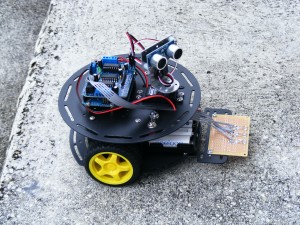
VEX IQ Robotics
The VEX IQ Robotics Competition for elementary and middle school students is open to teams of two or more kids who build a robot to compete in local competitions.
While it's really exciting and fun, it's easy to feel overwhelmed due to the open-endlessness, and that's what we're going to hep you with. Ready to get started?
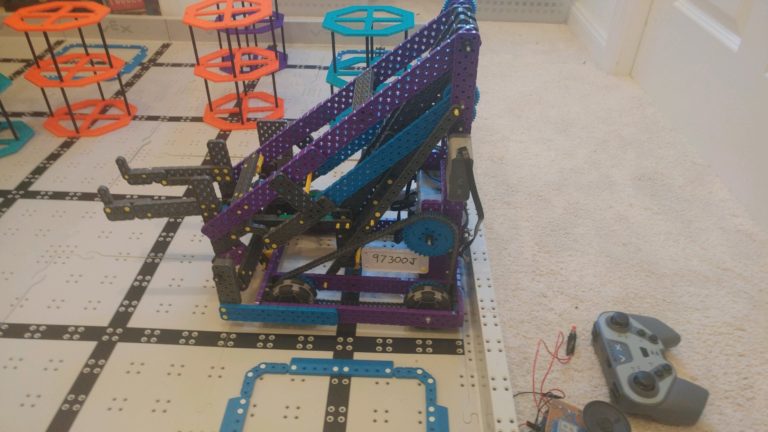
Science is always easier to learn when you can practice it hands on. As a homeschooling family you would have no doubt had some experience with conducting scientific experiments based on what your child’s lessons include. This has to have benefited the homeschool science student greatly, but it is still school work.
Have you ever done something fun which involves using a science principle with your homeschool students? Something that you did just for a lark? Here are a few suggestions for you to have some homeschool science based fun!
Please login or register to read the rest of this content.
If you have chosen to follow the homeschooling path as a single parent, you will need to be very well organized. Particularly when it comes to handling the home school science curriculum with your child. Whatever the circumstances why you have chosen to home school, they should not interfere with you giving your child the best possible experience in the study room. Please login or register to read the rest of this content.
Doing science is exciting, fun, and full of big ideas! Why bother with writing when you could be mixing up chemicals, blasting rockets, or shattering laser beams?
Did you have a teacher that really had an impact on you? Remember the excitement? Or the thrill you felt when you taught something to someone else and they really got it? First, let me thank you for your commitment to education – a value that is high enough for you that you are stretching for resources to help you reach your goals. In this article, I am going to share with you some of the common mistakes that educators often make.
Science is more than a classroom… it’s actually pretty difficult to define. Science is not about what we know, but rather about how we face what we don’t know. It’s not a textbook of principles, set of rules, or collection of factoids. It’s a process, a thing you do. Science is what happens when you ask questions, get back answers, and try to figure and make sense of it all.
Have you ever picked up a textbook, filled out a worksheet, or done a science activity and wondered…“What is my child really learning with this?” Parents wonder exactly what bases they should cover for their kids to understand science before they hit the high school or college scene.
Did you ever have a teacher that made a real impact on you? They took a subject you previously thought was dull and boring and somehow made it jump alive? Special teachers can touch our lives in small ways that make big changes later in life by phrasing a topic into just the right words so it really clicks for you, or simply just believing in you when no one else around you did. These types of teachers are pretty amazing when it comes to inspiring children. If you’ve ever wondered how some of them ‘work their magic’, you’re not alone. Most amazing teachers really couldn’t tell you how they do what they do – they just know how to reach kids effectively in a way that really makes an impact.
Are you using another curriculum alongside the eScience program? This match-up sheet will help you really bring the scientific principles from your textbook to life and show you which experiments and activities work best with the chapter you currently on.
Kids love my new twist on the classic game of Monopoly. Besides being chocked full of real photographs of celestial objects, it’s simple to set up and easy to play.
Have you ever torn apart something and then couldn’t figure out how to get it back together again so that it worked? Worse, you knew that if you had only taken a few moments to think about the problem or jot something down, you know it would have taken you far less time to figure it out?
I share some of my top secrets with you so you can do the same with your own children! If you set it up right, you will no longer need to push your child to learn, but rather your child will be naturally pulled toward it in a way that lasts long-term. We’ll uncover the ten modes of motivation and the four different types of learning so you can enter your child’s world and meet them at their level, and you will walk away with a game plan for getting the most out of your learning time together.
What science equipment is best for your dollar? Which ones will wind up dusty and unused, and which will get used everyday? When it okay to go for cheap over quality? Read more to find out.
I know the e-Science is super-massive, with over 900 experiment videos and 2,000+ pages of lesson plans… it can get overwhelming! If you’d like a fun place to start to give your kids a sample of how science can be fun and educational, you’re going to enjoy this page.
These are the videos and manual that make up the “Science Activity Video Series” we publish to give students a taste of what science can really be like. Embedded in each one are links to watch step-by-step instructional videos for doing each experiment in the accompanying manual. You’ll need the latest version of Adobe Acrobat Reader to view the files (they are PDFs). Start reading and when you’re ready to do an experiment, click the link inside the booklet to watch the videos.
Your access code is: ESCIM (You’ll need it to watch the embedded videos). You don’t have to go in any particular order… feel free to skip around!
|
|
||||||||
|
|
||||||||
|
|
||||||||
|
|
||||||||
|
|
||||||||
Please login or register to read the rest of this content.
Have you ever picked up a textbook, filled out a worksheet, or done a science activity and wondered…“What is my child really learning with this?” Parents wonder exactly what bases they should cover for their kids to understand science before they hit the high school or college scene.
Most kids love the idea of science – of building things, creating inventions, and getting stuff to work by using their own two hands. Kids have a natural passion for science. The problem comes in when the parent feels they can’t meet this need in their child, and they struggle with how to fulfill it.
Have you ever torn apart something and then couldn’t figure out how to get it back together again so that it worked? Worse, you knew that if you had only taken a few moments to think about the problem or jot something down, you know it would have taken you far less time to figure it out?
I gave a teleclass on the biggest *oops!* found in science textbooks, and in addition to the teleclass recording, I thought you’d enjoy an excerpt from my notes. If you’ve found one or more of these in your books, it’s not the end of the world… but this may raise your awareness a few notches.
This article will outline the basic fundamental concepts in physics and give you real hands-on experiments you can share with your child that they will love. I’ve been teaching physics from grade school through college, and in this article I am going to address the common myths and misconceptions about physics and help you set the record straight.
Click for a printer-friendly version of this page.
Click here to for the teleclass audio recording.
Please login or register to read the rest of this content.
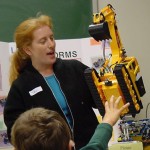 How to Teach Science That Kids Really Enjoy AND That’s Easy To Teach.
How to Teach Science That Kids Really Enjoy AND That’s Easy To Teach.
You CAN do this for your own kids. It’s not that hard. You just need to know the right steps AND sequence. Kind of like baking a cake. You need the right ingredients, AND you need to mix them in the right order. In this slide-show presentation, I’m going to share with you…
- How to teach your kids science in a way that makes it a part of understanding the world around them (not as some abstract concepts in a book).
- How to make learning real science totally fun for your kids (and I mean both the hands-on experiments AND the academic stuff that they should know).
- How to get your kids super-excited about learning science (or any subject)
- The easy way to teach science, even if you’re not exactly a science guru yourself.
- How to teach your kids the kind of hands-on science that will help them be successful in life when they finally head off to college or to find a job (even if it’s not in a science-related field).
- And much, much more!
I’ve never done this type of presentation before, so please be patient with me! Sometimes I get off on a tangent and take forever to change to the next slide… but I promise, it’s worth it. If you take away only one or two small things that can really make a difference for your kids (and you), then it was worth your time.
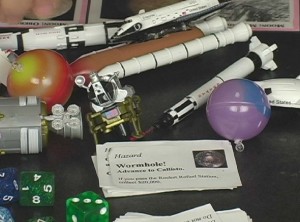 Kids love my new twist on the classic game of Monopoly. Besides being chocked full of real photographs of celestial objects, it’s simple to set up and easy to play.
Kids love my new twist on the classic game of Monopoly. Besides being chocked full of real photographs of celestial objects, it’s simple to set up and easy to play.
This game plays exactly the same as Monopoly, only there are comets instead of railroads, black holes and neutron stars instead of income tax, rocket repair stations instead of jail, community quasars, and much more!
My kids and I have played this game for hundreds and hundreds of hours using these simple templates that I’ve put together for you. The only additional items you will need to find are rocks and dice – which I assume you already have access to. Everything you need to create your own homemade version of this game is right here: Click to download the Space-opoly Templates
Please login or register to read the rest of this content.
After putting together this video, it is so clear what makes some kids successful when it comes to school and why others really struggle.
Motivation. That’s it.
And, I also know it’s not that simple to motivate kids, but stick with me for a minute…
Please login or register to read the rest of this content.
If only you could keep better track of big numbers, adding and multiplying your head wouldn’t be such a problem! But fear not… I have a trick that might be just the ticket for your brain!
Use this secret phonetic math code to code and decode sentences into numbers. Developed over a hundred years ago, this is the code that the expert mathematicians use when doing large calculations in their head. This is exactly how Arthur Benjamin squares 5-digit numbers without a calculator!
Please login or register to read the rest of this content.
 If you’ve ever wanted to sneak a peek into my cabinet of educational games and books for kids, now is your chance. Use this list for gift ideas, boredom busters, and just plain family fun. Some of these games you can pick up at the store, and the rest are the home-made, print-it-out, cut-and-play variety that your kids will really learn from.
If you’ve ever wanted to sneak a peek into my cabinet of educational games and books for kids, now is your chance. Use this list for gift ideas, boredom busters, and just plain family fun. Some of these games you can pick up at the store, and the rest are the home-made, print-it-out, cut-and-play variety that your kids will really learn from.
I first made this list because I felt that so many games are watered-down versions of either bingo or “roll the dice and see where you land”, with the occasional card pick. I was curious to see if there were any truly great educational games still available, or if they were all just brain candy.
My games listed here are designed to develop strategy, critical thinking, and chaotic surprise in addition to having the kids learn practical knowledge along the way (not trivial fluff). And when a kid memorizes the card deck, it works in their favor because now they know the entire periodic table.
Here you’ll find games including arithmetic, fractals, equations, chemistry, physics, and more. If you have any you’d like to add to the pile, just submit it in the comments section so everyone can benefit. Are you ready?
Note: This list is growing so please check back for updates!
Favorite Books
- Why Pi? by Johnny Ball
- Go Figure by Johhny Ball
- The Space & Time of Uncle Albert by Russell Stannard
- Black Holes and Uncle Albert by Russell Stannard
- Uncle Albert & the Quantum Quest by Russell Stannard
- George’s Secret Key to the Universe by Lucy & Stephen Hawking
- George’s Cosmic Treasure Hunt by Lucy & Stephen Hawking
- The Elements by Theodore Gray
- Dr. Wright’s Kitchen Table MathThere are three in this set
Favorite Resource for Science Supplies
A lot of science supplies can be purchased online these days, especially the hard to find stuff. However, if you’re in the market for oddball items from a company that reuses industrial overruns, here it is:
- RAFT Resource Area For Teaching RAFT (Resource Area For Teaching). When I was first starting out, I would take a pickup truck to RAFT in San Jose and load up on everything I needed to teach science for the month. Since I was teaching at 60 different schools (about 50 classes per week), I went through a LOT of materials… and I knew I had to get them inexpensively. RAFT has grown a lot over the years, and if you’ve never had the opportunity before, now is your chance to check it out for yourself.
- Educational Innovations is the place I got a lot of my physics stuff when I was teaching at the university.
- Sci-Supply is an inexpensive physics store with lots of great stuff for smart kids.
- Science First is where I get a lot of my higher-end, more commercial grade physics demos.
Favorite Science Games
- Space-opoly (My kids love my version of the classic Monopoly)
- Chemistry Period Table Board Game
- Periodic Quest This game won numerous awards and is a recent release
- Chemistry Card Game (Amazon)
- Elementeo developed by a very talented school-age student which teaches kids the characteristics of the periodic table of the elements using a game structure similar to Magic
- Solar System Treasure Hunt This one is included because it’s so fun the first time!
- The Way Things Work Board Game
- Cells Alive! Puzzles and Crosswords online
- Black Hole Game Written and created especially by scientists!
- Constellation Board Game Plays northern hemisphere on one side and southern on the other!
 Math Games
Math Games
- Equate the Math version of Scrabble, which is great for kids that are getting the hang of arithmetic
- Best Dice Game for honing math skills – I keep a set in my purse wherever I go (no kidding!)
- Monopoly using a third and fourth die to calculate tax for purchases or compound interest (for rate and time); federal income tax brackets (which depend on your capital) replaces the ‘income tax’ square… we try to make it as realistic as we can, and even do the ‘bidding option’ stated in the rules when buying property.
- Mathematician Dice
- Cryptarithms (one of my favorite math games – it’s the image of “SEND MORE MONEY” at the above right – you have to figure out what number each letter represents!)
- More Math Recommendations
Awesome Games Overall
- Chess find a 34-piece set (with four queens) and a vinyl mat
Intelligent Music for Kids
(that doesn’t make adults want to rip their hair out)
-
- The Element Song by Tom Lehrer
Here’s the video of the Element Song:
-
-
-
- The Nano Song (audio only) based on nanotechnology
-
-
Here’s the video of the Nano Song:
- Supernova Bounce is a jazzy, upbeat, accurate song about exploding stars
- Cute little song about Hooke’s Law and Newton’s Laws (F=kx and F=ma)
- Story-like song about Snell’s Law (which has to do with the way light crosses between one medium to another)
- The Relativity Song that’s a favorite of mine! We dedicate an entire lesson to this topic in Unit 7
- A cute little song about Amphere’s Law.
- A very accurate Hydrogen Line Song about how we can use filters to view the sun and see what it’s made up of
- Rudolf the Bright Red Photon and other holiday songs about physics
Note: You can find more songs at the Harvard Physics Song site, but be sure to preview them before sharing them with your kids as they are more appropriate for college-level students!
What Pi Sounds Like by Michael Blake (see video below):
 Most kids love the idea of science – of building things, creating inventions, and getting stuff to work by using their own two hands. Kids have a natural passion for science. The problem comes in when the parent feels they can’t meet this need in their child, and they struggle with how to fulfill it.
Most kids love the idea of science – of building things, creating inventions, and getting stuff to work by using their own two hands. Kids have a natural passion for science. The problem comes in when the parent feels they can’t meet this need in their child, and they struggle with how to fulfill it.
We’re going to take a look at what happens long-term when you don’t meet this need, and how you can avoid these pitfalls by following three simple steps today. But first, let’s take a look at what passion really is.
Click here for a printer-friendly version of this page.
Having a passion for science isn’t a switch that gets flipped on one minute and off the next. Rather it is the result of small and consistent actions taken every day. If these actions empower your child and nurture their curiosity, then you’ll see the interest spark into a flame of passion and creativity.
Unfortunately, there are still a lot of textbooks and teachers out there that do the exact opposite – they slowly chip away at a student’s passion, not consciously aware that they are doing it, until one day that passion for science disappears altogether.
This article is the result of interviewing dozens of people who have had this experience specifically in science, and the issues they face today as adults. All of these folks have one thing in common: they once had a brilliant spark of interest for science, but ‘something happened’ along the way. These people are from all over the board: auto mechanics, grocery store managers, hair dressers, stay-at-home moms, newspaper journalists, and one even was still flipping burgers. They feel an innate regret about being turned off to science, not knowing why or how it happened.
We are going to take a look at the effects of not feeding a child’s passion for science, some of which might be new for you to think about. I share this with you now you can learn from people who already know what the road ahead looks like. If you find you’re doing some of the things here, don’t feel bad – someone may have not told you about this before. We’re also going to look at the three simple things you can do to avoid this type of future for your child.
Are you ready to get started?
Please login or register to read the rest of this content.

You’ll learn my 6 keys to getting kids to want to learn science, and for teaching it in a way that takes less time and is more effective (Otherwise known as the 6 mistakes parents make in teaching homeschool science).
Some of the topics we’ll cover include:
- How to teach science in a way that really works. Your kids will learn better and it will take you less time to teach it!
- How you can include academic material in a way that gets kids really excited about learning more.
- How to take what kids learn from an intellectual level of understanding to an everyday applied level. This way they’ll learn the foundation they really need to be successful in college and especially when they go looking for a job someday.
- …and more!
Here’s how to access this information:
Please login or register to read the rest of this content.
 Are you using another curriculum alongside the eScience program? This match-up sheet will help you really bring the scientific principles from your textbook to life and show you which experiments and activities work best with the chapter you currently on.
Are you using another curriculum alongside the eScience program? This match-up sheet will help you really bring the scientific principles from your textbook to life and show you which experiments and activities work best with the chapter you currently on.
Note: The eScience program does not cover creation or evolution so ALL families can participate with our programs. We focus on how to build the robot, take data and measurements, work a microscope, launch the rocket, why a laser works…basically sticking to the physics of what’s going on and how to build the projects. Of course, you can always add to it in any way you see fit.
The conversion charts we provide are for most requested texts from our members. For other curriculum, simply email us your TOC and we’ll create a conversion chart for you and post it here.
Which Standards are Met by e-Science?
Click on the link below to download the PDF file.
- A Beka
- Apologia
- Apologia General
- Apologia Physical Science (Middle/HS)
- Apologia High School Chemistry (High School)
- Building Foundations of Scientific Understanding
- Bob Jones
- Classical Conversations
- God’s Design
- Real Science 4 Kids
- The Noah Plan
- K12.com Online Course
- Alpha Omega Switched On School House and Lifepac Series
- Considering God’s Creation
- Science of Physical Creation
- Noeo Chemistry Curriculum
- Christian Kids Explore Creation
- Secrets of the Universe by Paul Fleisher
- Rainbow Science
- Classic Science: Physical Science
- Science: A Closer Look
- Singapore Early Bird Books (1-4)
- Science Foundations
- Prentice Hall Physical Science
- REAL Science Odyssey (Life)
- Saxon Physics Curriculum
- Noeo Physics Curriculum
- Science Fusion Grade 5
If you also own the Science Mastery Program, here are the conversion charts between Science Mastery and e-Science:
Science Mastery Program (Silver, Gold, and Diamond) Topics and Subject Areas
Which Materials Do I Need to Get? Determine which materials you can use from your Science Mastery box(es) with the e-Science program
 Are you using another curriculum alongside the eScience program? This match-up sheet will help you really bring the scientific principles from your textbook to life and show you which experiments and activities work best with the chapter you currently on.
Are you using another curriculum alongside the eScience program? This match-up sheet will help you really bring the scientific principles from your textbook to life and show you which experiments and activities work best with the chapter you currently on.
Note: The eScience program does not cover creation or evolution so ALL families can participate with our programs. We focus on how to build the robot, take data and measurements, work a microscope, launch the rocket, why a laser works…basically sticking to the physics of what’s going on and how to build the projects. Of course, you can always add to it in any way you see fit.
The conversion charts we provide are for most requested texts from our members. For other curriculum, simply email us your TOC and we’ll create a conversion chart for you and post it here.
Which Standards are Met by e-Science?
Click on the link below to download the PDF file.
- A Beka
- Apologia
- Apologia General
- Apologia Physical Science (Middle/HS)
- Apologia High School Chemistry (High School)
- Building Foundations of Scientific Understanding
- Bob Jones
- Classical Conversations
- God’s Design
- Real Science 4 Kids
- The Noah Plan
- K12.com Online Course
- Alpha Omega Switched On School House and Lifepac Series
- Considering God’s Creation
- Science of Physical Creation
- Noeo Chemistry Curriculum
- Christian Kids Explore Creation
- Secrets of the Universe by Paul Fleisher
- Rainbow Science
- Classic Science: Physical Science
- Science: A Closer Look
- Singapore Early Bird Books (1-4)
- Science Foundations
- Prentice Hall Physical Science
- REAL Science Odyssey (Life)
- Saxon Physics Curriculum
- Noeo Physics Curriculum
- Science Fusion Grade 5
If you also own the Science Mastery Program, here are the conversion charts between Science Mastery and e-Science:
Science Mastery Program (Silver, Gold, and Diamond) Topics and Subject Areas
Which Materials Do I Need to Get? Determine which materials you can use from your Science Mastery box(es) with the e-Science program
 When I teach a science class, this is the questions I get asked most: “What science stuff does my child need to learn?” Parents are wondering exactly what bases they should cover for their kids to understand science before they hit the high school or college scene.
When I teach a science class, this is the questions I get asked most: “What science stuff does my child need to learn?” Parents are wondering exactly what bases they should cover for their kids to understand science before they hit the high school or college scene.
This is a difficult question to answer, partly because it depends on what your ultimate goals are. If your child wants to just get his feet wet and see what all the fuss is about, then grab a couple of science kits and just play. On the other hand, if your kid reads every science text on the planet and is still thirsty for more, there are a few basics you can cover to be sure she is both well-rounded and happy about learning.
There are 18 main principles in science, ten of which kids need to know and understand before they hit college. (As a college professor myself, I’ve seen senior students struggle with these basics that they should have mastered years ago.) And these principles are…
Please login or register to read the rest of this content.
 Have you ever picked up a textbook, filled out a worksheet, or done a science activity and wondered…“What is my child really learning with this?” Parents wonder exactly what bases they should cover for their kids to understand science before they hit the high school or college scene.
Have you ever picked up a textbook, filled out a worksheet, or done a science activity and wondered…“What is my child really learning with this?” Parents wonder exactly what bases they should cover for their kids to understand science before they hit the high school or college scene.
Before you can teach your kid science, you’re going to need a basic science understanding yourself. We’ve prepared a science quiz to see where you are and how you’re doing. This is portion of the same quiz we give the kids during our science workshop, so you can test them again after the workshop is over to see how well they’ve pick up the stuff. So take a few minutes and give it your best shot. Good luck.
Please login or register to read the rest of this content.
12 Ways to Transform a Teaching Nightmare into an Educator’s Dream
Did you ever have a teacher that made a real impact on you? They took a subject you previously thought was dull and boring and somehow made it jump alive? Special teachers can touch our lives in small ways that make big changes later in life by phrasing a topic into just the right words so it really clicks for you, or simply just believing in you when no one else around you did. These types of teachers are pretty amazing when it comes to inspiring children. If you’ve ever wondered how some of them ‘work their magic’, you’re not alone. Most amazing teachers really couldn’t tell you how they do what they do – they just know how to reach kids effectively in a way that really makes an impact.
One of the main differences between an outstanding teacher and a dud is their ability to enter the student’s world and find out not only where they are, but also where they are coming from. In this way, teachers can structure lessons in a way that not only motivates the child to learn, but instills a deep curiosity that will continue this love of learning for the long-term.
When you truly learn how to motivate people using their preferences (not yours), you open the vault because you hit all the right access codes and can enter into their world to really make an impact on them. Think of it this way: it’s equally important how you deliver the message as well as the message itself. And when you truly understand your child’s motivational programming, you can enter their world and guide them on their path in a meaningful and impactful way.
Note that you don’t need to do all of these. Simply focus on one or two until see a change in the way your child learns. Then come back for more. Are you ready?
Paint a vivid future. Some people get really excited about moving toward a goal when you paint a picture about how great it can be. A boss at work talks about all the great projects this month, your spouse talks about next year’s vacation, or maybe you have a picture of your dream house on the wall that really inspires you to take action. For some, this is enough to inspire them to move into action. But not others.
Emphasize consequences. Other people need to really understand the consequences if they don’t move into action. These folks turn in the report at deadlines, wait until the last minute to make hotel reservations, and respond better when the worst-case scenario is painted before them.
Which one is better? Neither. One type of motivation is not right or wrong – they just are. And while we all have both, most people have a stronger preference for one. Can you see how you’d use different words with one type of child than another? “Feel free to keep the toys you clean up” may work better than “You may join us for ice cream when you’re finished cleaning your room”. Either way, it’ll be fun to figure out.
Noticing sameness. Toss three quarters on the table and ask your child to describe what landed on the table. We call these types of kids ‘matchers’. Matcherstalk about how they are all the same, all round, all silver. Matchers are a teacher’s dream to work with – they often are associated with positive attitude or optimism, and are easy to motive into action by drawing parallel examples.
Pointing out the difference. On the other end of the spectrum is the teacher’s nightmare: the kid who contradicts everything, points out every little difference in detail, appears defiant, and is often associated with the term ‘devil’s advocate’. Mismatchers playing the quarters game mentioned above will notice the one that is tails-side up, a different year, or cleaner than the rest. To motivate a mismatcher, simply use ‘reverse psychology’, but you need to do this with complete congruence if it’s going to work. This means there is no twinkle in your eye when you work with them – you are honestly entering their world and using their own motivation and doing it with integrity and caring for who they are and where they’re at.
In short: make sure they don’t know what you’re doing. It sounds so simple. And it is, as long as you are doing it from a place of honest caring and seriousness.
“I just know.” How do you know when you’re really good at something, or when you’ve really done a good job? Kids that ‘just know’ are internally motivated, meaning that they don’t ask around to see what other people think… the sense of certainty comes from within themselves. You can’t pressure an internally motivated person into doing something with peer pressure – it’s just not motivating to them. However, you can tap into their internal judgment system to guide them along.
Imagine what happens when a car salesman wraps up the conversation with an internally motivated person and says: “I can’t convince you whether this car is right for you or not. Only you can do that. I do know that you’re not going to be happy with a car that you know to be second-best.”
“What would they think about this?” Externally motivated people rely on the opinion of others to see what they should do. This one needs special care, as you don’t want to send the message to your child that you’d love them less if they don’t do something. Be sure to separate the child from the behavior when motivating an externally-motivated kid. “Hmmm… how do you think your friends are going to like being around you when you don’t bathe for a week?”
Go with the flow. Kids that enjoy the process, especially if a creative one, truly have fulfillment in the act of writing, researching, figuring out life’s problems, whether math, science, or how to fix the toilet. They really like the process and really aren’t motivated by someone telling them about what they can do when they’re finished. Kinesthetic kids are often in this class of motivation, as they like to fully associate with the process, feelings, and everything that goes with it. “Want to help fix the car after your math is done?”
Finished! However, other kids simply want it to be done and are motivated by the feeling of completion. These types of kids are compelled to complete the worksheet, put a word on every line in a notebook, or fill out a form entirely. They will often stick with a project just to feel the gold that comes at completion.
Paint the big picture. Some kids are happy to simply skim over and just get the main idea. Big picture kids get excited when you sketch out the framework, so painting a bold, bright picture of what they’re aiming for is essential before they feel comfortable moving into action.
Give me the details! Sometimes, people want to know all the little details of the process, and only get excited when they hear the intricacies of the event. It’s easy to motivate these types of kids – just take them through what it will be like, keeping in mind whether they are more receptive to visual, auditory, or kinetic communication. (For visual communicators, talk faster and paint a bright picture; for auditory, slow it down a notch and use words like ‘hear’ and ‘listen’; slow things way down for kinesthetic communicators and include feeling and touch sensory words.)
Past performance. Some people are impressed by a how long a company has been in business (“Serving you since 1932…”). Some kids relate past performance to equal the future (“Math never makes sense…”) so finding their top three greatest moments of their life (according to them, not you) is a great anchoring technique. When they get stuck, simply reference these and draw parallel examples of how now is like it was then.
Future possibilities. Others are more interested in what the company can do for them in the future (“I could tell you how long we’ve been around, but let’s focus instead on what we can build together…”). Some kids forget the past and see only future possibilities (“I wonder what I’ll get to try out this week in math…”). Kids that picture themselves as firemen, train engineers, doctors, etc. and use it to do something are all using future possibilities as a motivational technique in that moment.
In conclusion…Whew! We’ve covered a lot of ground here. Remember, you don’t have to use all of these, or even half of them. The point here is to really understand motivation and the fuel behind it so you can enter your child’s world elegantly and with true caring for where they are at so you can provide the most effective guidance along their path.
One of the most important jobs you have as a parent is to empower your child so they can do well in the world. While we’ve given you the tools for motivation, you also need to remember to stand back and let your kids ‘take on’ their own education, with you cheering for them on the sidelines. Enjoy the adventure and don’t forget to play with your kids along the way!
Click here for a printer-friendly version of this page.
…and What to Do About Them.
 Did you have a teacher that really had an impact on you? Remember the excitement? Or the thrill you felt when you taught something to someone else and they really got it? First, let me thank you for your commitment to education – a value that is high enough for you that you are stretching for resources to help you reach your goals. In this article, I am going to share with you some of the common mistakes that educators often make.
Did you have a teacher that really had an impact on you? Remember the excitement? Or the thrill you felt when you taught something to someone else and they really got it? First, let me thank you for your commitment to education – a value that is high enough for you that you are stretching for resources to help you reach your goals. In this article, I am going to share with you some of the common mistakes that educators often make.
If you’ve fallen prey to one or more of these, it simply means that no one told you about them yet. Once you know, you can then focus on solutions. Or, perhaps you’ll find that you are already on track, and this may reaffirm that you are headed in the right direction. Are you ready?
Please login or register to read the rest of this content.
Aurora will share some of her top secrets with you so you can do the same with your own children. If you set it up right, you will no longer need to push your child to learn, but rather your child will be naturally pulled toward it in a way that lasts long-term. We’ll uncover the ten modes of motivation and the four different types of learning so you can enter your child’s world and meet them at their level, and you will walk away with a game plan for getting the most out of your learning time together.
Please login or register to read the rest of this content.
 I’ve been traveling a lot lately and after seeing what’s on the market for science equipment… well, I just had to write this article to help you separate the trash from the treasures. (I’ve been to 13 different educational conventions in 16 months, 17 weeks of science camps, and countless other science-related workshops!)
I’ve been traveling a lot lately and after seeing what’s on the market for science equipment… well, I just had to write this article to help you separate the trash from the treasures. (I’ve been to 13 different educational conventions in 16 months, 17 weeks of science camps, and countless other science-related workshops!)
NOTE: These are the items that I personally use in my teaching and science recreation, and thought I would pass them along to you, from one science educator to another.
I’ve focused mostly on the big-ticket items, the ones that will put the biggest hole in your wallet if you’re not careful. With these tips, you’ll be able to turn those hard-earned dollars into a sound investment in your child’s education and journey toward life-long learning.
The three most important things you can give your child:
Please login or register to read the rest of this content.
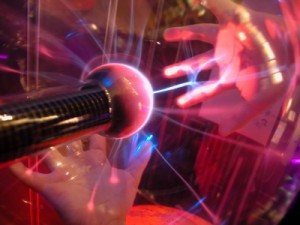 Sometimes I’m lucky just to get my teeth brushed in the morning, let alone design an experiment that illustrates Einstein’s photoelectric effect for my 7-year old son. Luckily, though, YOU don’t need to reinvent the wheel (or the light bulb), because here’s a quick list of cheap and easy experiments that really drive home the basic principles in physical science.
Sometimes I’m lucky just to get my teeth brushed in the morning, let alone design an experiment that illustrates Einstein’s photoelectric effect for my 7-year old son. Luckily, though, YOU don’t need to reinvent the wheel (or the light bulb), because here’s a quick list of cheap and easy experiments that really drive home the basic principles in physical science.
I was thinking of titling it Quality Science in a Hurry on a Shoestring Budget. But what do you think?
Please login or register to read the rest of this content.
 Click here for a printer-friendly version of this page.
Click here for a printer-friendly version of this page.
Science is more than a classroom… it’s actually pretty difficult to define. Science is not about what we know, but rather about how we face what we don’t know. It’s not a textbook of principles, set of rules, or collection of factoids. It’s a process, a thing you do. Science is what happens when you ask questions, get back answers, and try to figure and make sense of it all.
Please login or register to read the rest of this content.
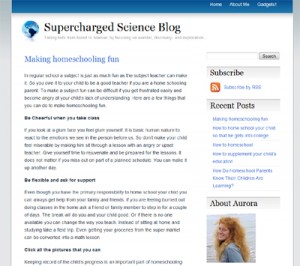 Get the latest tips and news from Supercharged Science through our Homeschooling Blog! We’ve posted articles about how to homeschool your child so that they get into college, how to supplement your child’s education, how to figure out if your child is really learning, how to make homeschooling fun, and more.
Get the latest tips and news from Supercharged Science through our Homeschooling Blog! We’ve posted articles about how to homeschool your child so that they get into college, how to supplement your child’s education, how to figure out if your child is really learning, how to make homeschooling fun, and more.
You’ll find new articles here every few days… it’s just one of the ways we stay in touch. If there’s something you’d like us to write about, just drop us a note – we’d love to hear from you about what you’d like to read about!







